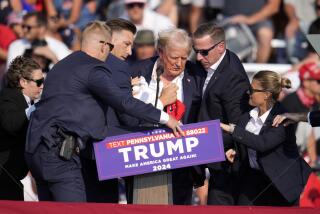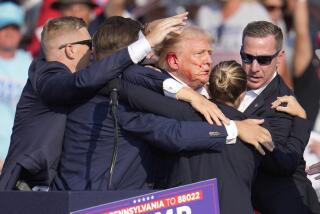Airport tests reveal major security flaws
Washington
Federal investigators smuggled the components of liquid-based bombs past screeners in 19 airports nationwide in secret tests earlier this year, showing that a terrorist could thwart the latest U.S. security regulations.
“Our tests clearly demonstrate that a terrorist group, using publicly available information and few resources, could cause severe damage to an airplane and threaten the safety of the passengers,” concludes a Government Accountability Office report that was released Wednesday night by the House Oversight and Government Reform Committee.
Using cheap, easily available components, GAO investigators made an explosive device and a firebomb that, when tested, exploded with sufficient force to cause significant damage. Investigators then used public information on the Transportation Security Administration’s screening procedures to devise ways to carry the bomb components through airport checkpoints without being challenged.
The oversight committee, headed by Rep. Henry A. Waxman (D-Beverly Hills), will hold a hearing today on the weaknesses identified in the 6-year-old agency’s operations. It will be the second hearing in two days called to highlight TSA’s shortcomings.
“The situation is unacceptable,” Waxman said. “There are too many vulnerabilities and we’ve got to fix them. It’s disappointing that after all the years we’ve had TSA in place and all the money, billions of dollars, that we have put into the problem, it’s still not fixed.”
In testimony today, TSA Administrator Kip Hawley is expected to tell the committee that his agency will adopt some of the GAO’s recommended changes and take a more aggressive, visible and unpredictable approach to security. But he also is expected to stress that TSA’s defenses are multilayered -- including measures such as canine teams in airports, hardened cockpit doors, special self-defense training for airline crews and thousands of armed pilots.
“Relying solely on security at the checkpoint or focusing all of our resources to defeat one threat is counterproductive and detracts from our overall mission,” Hawley is scheduled to say in written testimony obtained by the Los Angeles Times.
James Jay Carafano, a domestic security expert at the Heritage Foundation, a conservative think tank, said TSA critics might have unrealistic expectations. “The system is never going to be perfect, it’s never going to stop everything,” he said. “The point is that screening was always meant to be largely a deterrent to definitely take amateurs off the field and deter the pros.”
Release of the GAO report follows a hearing Wednesday in which Hawley vehemently denied that screeners had been tipped off about covert security tests, even as lawmakers brandished an e-mail from TSA headquarters that not only warned employees of testing, but described the methods and appearance of those conducting the probes.
“There was no intent to tip off, there was no cheating,” Hawley insisted. He said that the e-mail was sent not to tip off screeners, but because a TSA official thought the tests might really be an Al Qaeda operation.
Democratic lawmakers were openly incredulous. “If you want me to believe that, I find that’s a stretch,” said Rep. Bill Pascrell Jr. (D-N.J.).
The hearing was unusually combative. Witnesses tried to talk over one another. TSA staff wrote anxious notes to Hawley as he testified, urging him to “change subject!” and “push back harder.” And Democrats ridiculed Hawley’s defense of his agency.
“How can you say there was no cheating?” queried Rep. Al Green (D-Texas), his voice rising. “This e-mail references a test that was going to take place.”
When Hawley replied that there was no breach in his agency’s integrity, Green shot back: “This is not about integrity, Mr. Hawley, this is about the truth.”
The e-mail, dated April 28, 2006, was sent to more than 650 employees and titled “Notice of Possible Security Test.” It began: “This information is provided for your situational awareness. Several airport authorities and airport police departments have recently received informal notice of possible DOT/FAA [Department of Transportation/Federal Aviation Administration] security testing at airports around the nation.”
The message also describes a couple who try to penetrate security, place improvised explosive devises on planes and test gate staff.
“The woman has an ID with an oriental woman’s picture, even though she is Caucasian. We are getting the word out,” the e-mail reads.
Hawley would not name the official who sent the e-mail, but said the employee had suspected the testing might be Al Qaeda at work, because neither the Transportation Department nor the FAA tests screeners.
The e-mail does not mention Al Qaeda or any terrorist threat.
The hearing was the latest by the House Homeland Security Committee to focus on screeners, who have shown little improvement in spotting explosives since the terrorist attacks of 2001.
Los Angeles International Airport screeners failed to spot simulated bombs in 75% of tests last year, according to recently disclosed TSA documents.
Lawmakers and witnesses said those failures had been compounded by a pattern of official leaks. Clark Kent Ervin, a former inspector general for the Department of Homeland Security, said cheating seemed to be a systematic problem.
And they questioned how screeners could perform so dismally when they were being forewarned about tests. “If screeners still fail tests that they know are being conducted, heaven help us when Al Qaeda next probes for weaknesses,” Ervin said.
Committee Chairman Bennie G. Thompson (D-Miss.) and others expressed frustration about continuing weaknesses at the Department of Homeland Security, which oversees the TSA. He noted that one of the busiest travel seasons of the year was about to start, with 27 million people set to fly worldwide over the next 12 days.
“Covert testers are there trying to expose gaps before a terrorist does, and if someone at TSA undermines this testing, they are undermining aviation security as a whole,” Thompson said.
Screener testing is done by the TSA, the Homeland Security inspector general and the Government Accountability Office, in response to requests from Congress.
The GAO’s recent covert security tests, which were done at Waxman’s request, identified serious weaknesses in the TSA’s procedures for screening passengers for dangerous liquids, gels and aerosol items. Those restrictions were adopted after British authorities uncovered a plot in August 2006 to blow up U.S.-bound airliners with liquid explosives.
Using publicly available information, investigators designed an improvised explosive device made of a liquid explosive and a detonator. They made a firebomb with “two commonly available products.”
Investigators bought the components at stores and on the Internet for less than $150.
The investigators then used easily obtainable information on TSA screening procedures to come up with ways to conceal the components in their carry-on luggage and on their bodies. The methods are classified. The investigators made it past the screeners at 19 airports -- which were not identified in the report -- in March, May and June.
Although the report notes a few interactions with screeners, it does not indicate that any screeners raised suspicions. In one case, a screener confiscated an unlabeled bottle of shampoo, but did not detect a liquid used to make an incendiary device.
Several descriptions of interactions with screeners suggest that, at least in some instances, the items were somehow carefully hidden on the investigator’s body.
In a May 8 incident, the report notes that an investigator deliberately put coins in his pockets to trigger a secondary inspection. The screener did both a hand-wand and pat-down search, the reports says, but “did not detect any of the prohibited items our investigator brought through the checkpoint.”
The report notes the specific GAO recommendations are “sensitive security information,” but said GAO officials advised that the TSA consider separate screening lines for higher-risk passengers and “individuals with special needs,” institute “more aggressive, visible and unpredictable deterrent measures” that could include pat-downs and hand-wand screening, and develop new technology “able to better detect concealed components.”
TSA officials told the GAO that they would examine the recommendations and noted that they were deploying “additional specialized personnel” to boost security, considering more training for screeners and looking for ways to transform “the culture of the workforce.”
nicole.gaouette@latimes.com
More to Read
Sign up for The Wild
We’ll help you find the best places to hike, bike and run, as well as the perfect silent spots for meditation and yoga.
You may occasionally receive promotional content from the Los Angeles Times.






